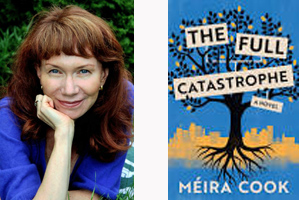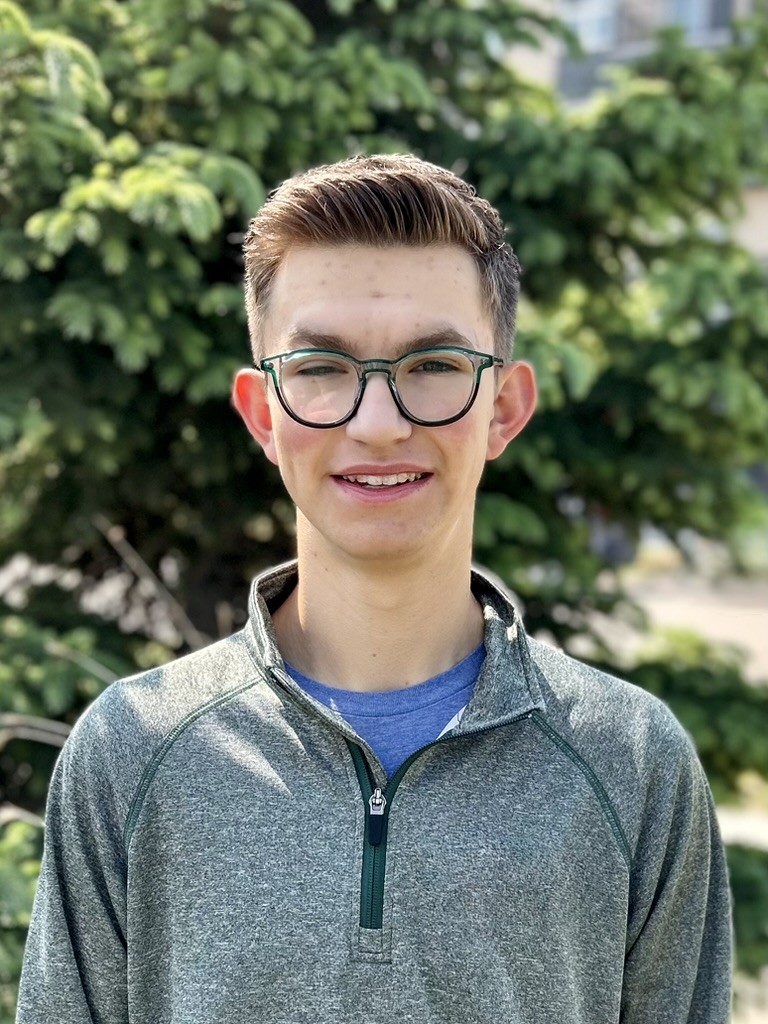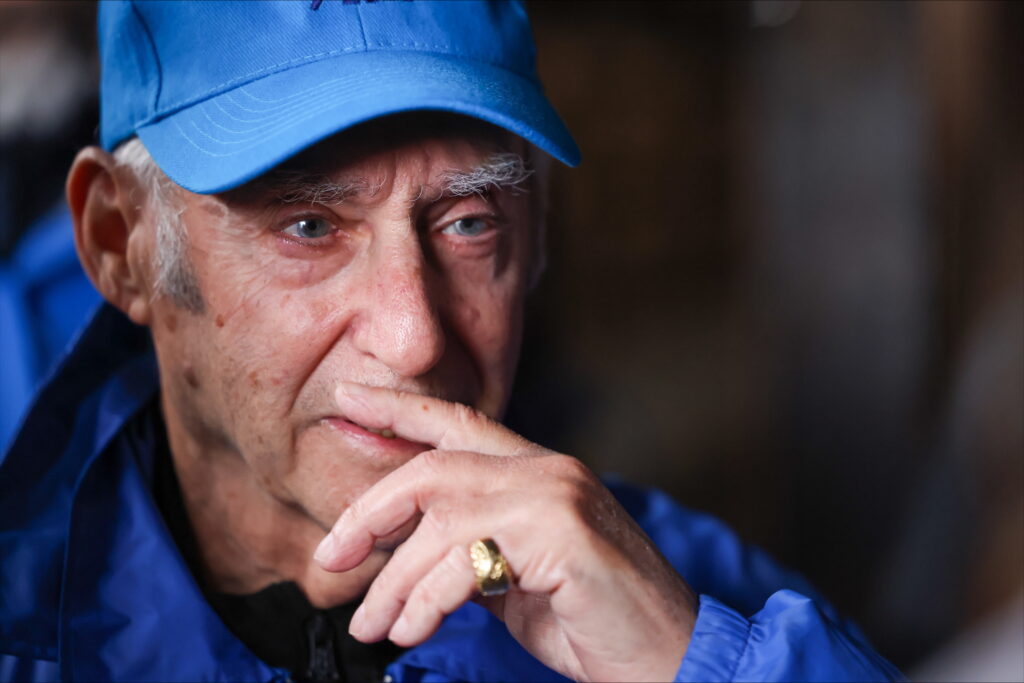Local News
Méira Cook’s latest novel is arguably her most “Jewish” one yet

Review by BERNIE BELLAN I’ve been following the career of poet and novelist Méira Cook ever since her name was first mentioned in this paper in an article written by my niece, Suzy Waldman, in 1995. At that time Méira (who is named for her late grandfather, Meir) noted that she had been sticking with poetry to that point, but was now considering switching to prose.
Well, what a transition it’s been. With the release of her first novel, “The House on Sugarbush Road,” in 2012, Méira has climbed near the top of the list of Manitoba’s most successful novelists. (That book won the McNally Robinson Prize for Book of the Year, by the way.)
In my review of “Sugarbush,” I noted that I was astonished by Méira’s facility with language, and I referenced her own description of having grown up in South Africa, having been exposed to the “snap and crackle of language”, whether it was spoken by whites or blacks.
That ear for language carried forward into Méira’s next novel, “Nightwatching,” which was released in 2015, and which was also set in South Africa. That book won the Margaret Laurence Award for Fiction.
Then, in 2017, Méira released her first novel set in her newly adopted home of Winnipeg, “Once More With Feeling.” I noted in my review of that book though that, if you haven’t read either of Méira’s prior novels, be forewarned:
“None of them unfold in a methodical, easy-to-understand pattern. As a matter of fact, the various chapters in ‘Once More With Feeling’ are largely disconnected. Characters are introduced, only to disappear for long stretches, sometimes appearing later in the book, at other times simply vanishing.”
Now though, Méira has, at long last, written a novel titled “The Full Catastrophe,” that might perhaps be the most accessible of all her novels to readers, in that it follows a more linear path in which characters remain throughout the novel without disappearing for long stretches. Like her three previous novels, however, “The Full Catastrophe” builds to a crescendo – and in this case, it revolves around a bar mitzvah.
Having said that, it must be apparent that this novel is the most clearly “Jewish” of any of Méira’s now four novels. The principal character, Charlie Minkoff, is a 13-year-old boy, who is born with “intersex” traits. Although Charlie clearly identifies as a boy, he is hampered by the ambiguity that his chromosomes have rendered.
Charlie though has a loving relationship with his zaida Oscar, who adores the boy and offers him the kind of emotional support that he so desperately needs.
Charlie’s mother, Jules Minkoff, on the other hand, is so completely involved in her own artistic pursuits that she leaves Charlie to fend for himself in the tenement building in which they live. (Jules, by the way, has lost the ability to speak – and she communicates with Charlie largely by leaving messages for him on a whiteboard.)
There are other characters who offer support to Charlie throughout the novel, particularly Weeza, a rough hewn female truck driver who strives to protect Charlie in the absence of Jules.
As I’ve already noted, Méira Cook is a master of fashioning dialogue. In “The Full Catastrophe” she demonstrates her facility with Yiddish idioms, as expressed by Oscar Minkoff. (Years ago Méira told me that she grew up in a household in South Africa where her grandparents spoke Yiddish. As a matter of fact, Méira speaks several languages, including Afrikaans and a few different black South African dialects. She was also a reporter early on, so being able to craft authentic sounding dialogue is something she honed while she was still quite young.)
Like her other novels, “The Full Catastrophe” is rich in description. Here’s a sample of how the author describes an ice warming hut on a Winnipeg river that Jules Minkoff has designed: “The ice was different from any he’d seen before. He’d been expecting kitchen cubes, the kind that turned opaque when wrenched from their trays. This ice was clear, so transparent he could make out fragile etchings of river scum in its depths – here a haze of silt, there a suspension of foam. The closer he looked the more he could see: a scrim of fish bones, a trail of bubbles, the current folding in on itself.”
In the ten years since Méira released “The House on Sugarbush Road” to today, it seems that she has also developed a keener sense of humour within her writing. Her first two novels, set as they were in South Africa, had as a backdrop the tensions between blacks and whites which pervade that country, and there was always a threat of impending violence within both those books.
“Once More With Feeling” took a decidedly less solemn path and it had several chapters within it that were predominantly humourous, although the book as a whole was quite serious.
In “The Full Catastrophe” Méira often injects entire scenes of dialogue that I told her in an email reminded me of Mordecai Richler in their tone. A good part of the book consists of emails sent back and forth between different characters, including a well-meaning teacher of Charlie’s by the name of Maude Kambaja, who wants Charlie to write an autobiographical essay for class, but who is dissatisfied with how Charlie avoids revealing much about himself.
Ms. Kambaja emails Jules Minkoff regularly to attempt to persuade Jules to exert her influence over Charlie to open up, but Jules consistently retorts in a most amusing and sarcastic manner.
Other characters in the novel, including two of Charlie and Jules’ neighbours in their building, which is known as the “GNC Building” (and from which all the remaining tenants will soon be forced to move as it’s about to be redeveloped), also carry on a hilarious exchange of notes for which Charlie serves as the messenger because they have such a strong dislike for one another.
Yet, through it all – including a crush that Charlie develops on a girl who herself is deeply scarred emotionally, the relationship between Charlie and his zaida is the overriding unifying theme of “The Full Catastrophe.”
Oscar Minkoff is himself a Holocaust survivor and after what he’s endured, he has nothing but compassion for his deeply troubled grandson (whose father abandoned him and his mother shortly after Charlie’s birth to join a Hasidic sect in New York).
Oscar decides that he wants to have a bar mitzvah – something he was never able to have in war-torn Europe, and he wants Charlie to participate with him in the event as well. As part of their preparation, Oscar and Charlie meet with a rabbi, during which they often engage in discussion of Talmudic passages.
(I was deeply impressed by the amount of research Méira put into developing those scenes. See adjoining sidebar for a more detailed examination of her writing process.)
No doubt, based on the past success of Méira’s other novels, “The Full Catastrophe” is going to enjoy a similar reception among her many fans. But, considering the more overtly Jewish storyline of this book, I would rather expect it to do particularly well with a Jewish audience. And, considering that Méira has been quite consistent in producing a new novel every three years for the past 10 years, I can hardly wait for her next one – which should be out in 2025, according to schedule.
“The Full Catastrophe”
Published by House of Anansi Press
376 pages
“The Full Catastrophe” will be publicly launched at McNally Robinson Booksellers on June 16 at 7:30 pm, when Méira Cook will be joined by Alison Gillmor in what Méira describes as “an evening of brilliant repartee, reading, and the joy of seeing each other once again!”
Méira Cook talks about her writing process
By BERNIE BELLAN Once I had finished reading Méira Cook’s latest novel, “The Full Catastrophe” I sent her a series of questions about this particular novel and about her writing process in general.
JP&N: Where did the idea for this particular novel come from? Was it something you had been mulling about for some time? I’m curious how someone with such a fabulous imagination comes up with their ideas?
Méira: My novel is a cross-over story for adults and teenagers about the different ways that masculinity is expressed in our contemporary world — whether religiously, socially, medically and familiarly — as well as the troubling ways that history intersects (collides might be a better word) with the present time. And I wanted to write about the relationship between two unlikely best friends, Oscar and Charlie, grandfather and grandson who, despite their differences in age and experience, love each other dearly.
JP&N: Was Charlie’s zaida based on one of your own grandparents in any way?
Méira: Charlie’s zeide is a product of imagination just as all my characters are. For me the imagination is a more hospitable narrative place than memory is because it owes no debt of accuracy to the dead. What has really delighted me is that some advance readers, including the journalists interviewing me, have shared very positive memories of their own grandparents that were sparked by reading Oscar. That ability for my imagination to connect with others’ memories is always tremendously rewarding.
JP&N: How much research did you have to do about intersex children? It was quite fascinating learning as much as I did from your book.
Méira: I did a great deal of research on intersexuality although I used relatively little of it as I didn’t want to bog down the story with too much exposition. My reading included scholarly texts, history, and memoir. It’s such an important and nuanced subject, and my research taught me so much about the history of intolerance and abuse relating to reassignment surgery, medical interventions, and the sometimes violent societal imposition of gender roles. This reading informed my writing in a fundamental way, but readers won’t come across it directly. My main concern in writing Charlie’s character is that he not be defined by his sexual characteristics. This, in my opinion, would repeat the violent impositions that I was reading about. Charlie’s got so many other interests, concerns, and qualities that have nothing to do with his sex chromosomes.
JP&N: If I have one quibble with the book, it’s that you have Charlie’s zaida constantly calling him “dahlink.” Don’t you think a term like that would only add to Charlie’s insecurity as a boy?
I would have preferred “boychik” as a term of endearment.
Méira: Luckily (and sometimes unluckily) we are not in charge of the terms of endearment offered us! They are what others call us. Oscar is so naturally loving, so open hearted despite his tragic experience in the Holocaust that he is the perfect friend, confidant, and grandparent for Charlie. His words to Charlie are always so filled with love that they could never make the boy feel insecure about anything. We should all be so lucky as to have a zeide like Oscar!
JP&N: I note that in past articles in our paper (beginning with a piece written long ago by my niece, Suzy Waldman), that you’ve stuck to a fairly consistent schedule when it comes to turning out something new: approximately every three years. Do you take a break between writing or do you go at it again immediately after finishing your last project?
Méira: I know many writers take breaks from writing after a large project, and I envy them. I love writing, and I wouldn’t feel healthy or grounded if I didn’t put in my time every day. I don’t work to a schedule until my publisher sets one, but I find the act of writing so necessary that I get out of sorts if I spend time away from my office.
JP&N: It goes without saying that this book is going to receive wide acclaim here in Manitoba. By the way, there were parts of the book that reminded me of Mordecai Richler when you have the email exchanges between various characters (or written notes, as the case may be). Your ability to capture someone through how they send an email, especially Ms. Kambaja, is just so real. You have such a great ear for dialogue. Does that still come from your reporting background?
Méira: Thank you for your kind words, Bernie. I’ve always loved Mordecai Richler, so the comparison is very flattering. I think my sense of dialogue comes from listening to people talk and reading good books. You need to be realistic with dialogue, but not too realistic, as real-life conversations aren’t usually interesting to outsiders. You need to write dialogue that sounds realistic but reads like fiction.
Local News
Further to the Simkin Centre’s financial situation

By BERNIE BELLAN A while back I published an article about the deficit situation at the Simkin Centre. (You can read it at “Simkin Centre deficit situation.“) I was prompted to write that particular article after reading a piece written by Free Press Faith writer John Longhurst in the August 5 issue of the Free Press about the dire situation personal care homes in Winnipeg are in when it comes to trying to provide their residents with decent food.
Yet, Longhurst made one very serious mistake in his article when he wrote that the “provincial government, through the Winnipeg Regional Health Authority, has not increased the amount of funding it provides for care-home residents in Manitoba since 2009.”
In fact, the WRHA has given annual increases to personal care homes, but its allocations are not broken down by categories, such as food or salaries. As a spokesperson for the WRHA explained to me in an email: “PCHs receive per diem global operating funding based on the number of licensed beds they operate. This funding model is designed to support the full range of operating costs associated with resident care, including staffing, food services, utilities, building operations, and other day-to-day expenses.”
Now, one can make a perfectly valid argument that the level of funding from the WRHA has not kept up with inflation, especially inflation in food costs, but the Simkin Centre is in an even more precarious position because of the skyrocketing cost of kosher food.
“In recent years,” according to an article on the internet, “the cost of kosher food has increased significantly, often outpacing general food inflation due to unique supply chain pressures and specialized production requirements.”
Yet, when I asked Laurie Cerqueti how much maintaining a kosher facility has cost the Simkin Centre, as I noted in my previous article about the deficit situation at Simkin, she responded: “approximately $300,000 of our deficit was due to food services. I do not have a specific number as far as how much of the deficit is a result of kosher food…So really this is not a kosher food issue as much is it is an inflation and funding issue.”
One reader, however, after having read my article about the deficit situation at Simkin, had this to say: “In John Longhurst’s article on Aug 5, 2025 in the Free Press, Laurie (Cerqueti) was quoted as saying that the annual kosher meal costs at Simkin were $6070 per resident. At Bethania nursing home in 2023, the non-kosher meal costs in 2023 were quoted as $4056 per resident per year. Even allowing for a 15% increase for inflation over 2 years, the non-kosher food costs there would be $4664.40 or 24% lower than Simkin’s annual current kosher food costs. If Simkin served non-kosher food to 150 of its 200 residents and kosher food to half of its Jewish residents who wish to keep kosher, by my calculation it would save approximately $200,000/year. If all of Simkin’s Jewish residents wished to keep kosher, the annual savings would be slightly less at $141,000.”
But – let’s be honest: Even though many Jewish nursing homes in the US have adopted exactly that model of food service – where kosher food is available to those residents who would want it, otherwise the food served would be nonkosher, it appears that keeping Simkin kosher – even though 45% of its residents aren’t even Jewish – is a “sacred cow” (pun intended.)
So, if Simkin must remain kosher – even though maintaining it as a kosher facility is only adding to its accumulated deficit situation – which currently stands at $779,426 as of March 31, 2025,I wondered whether there were some other ways Simkin could address its deficit while still remaining kosher.
In response to my asking her how Simkin proposes to deal with its deficit situation, Laurie Cerqueti wrote: “There are other homes in worse financial position than us. There are 2 homes I am aware of that are in the process of handing over the keys to the WRHA as they are no longer financially sustainable.”
I wondered though, whether the Simkin Centre Foundation, which is managed by the Jewish Foundation of Manitoba might not be able to help the Simkin Centre reduce its deficit. According to the Jewish Foundation’s 2024 annual report, The Saul and Claribel Simkin Centre Foundation, which is managed by the Jewish Foundation, had a total value of $11,017,635.
The Jewish Foundation did distribute $565,078 to the Simkin Centre in 2024, but even so, I wondered whether it might be able to distribute more.
According to John Diamond, CEO of the Jewish Foundation, however, the bylaws of the Foundation dictate that no more than 5% of the value of a particular fund be distributed in any one year. There is one distinguishing characteristic about the Saul and Claribel Simkin Centre Foundation, in that a portion of their fund is “encroachable.” The encroachable capital is not owned by JFM. It is held in trust by JFM but is beneficially owned by Simkin, similar to a “bank deposit”. While held by the JFM, these funds are included in the calculation of Simkin’s annual distribution.
I asked John Diamond whether any consideration had been given to increasing the distribution that the Jewish Foundation could make to the Simkin Centre above the 5% limit that would normally apply to a particular fund under the Foundation’s management.
Here is what John wrote in response: “The Simkin does have an encroachable fund. That means that at their request, they can encroach on the capital of that fund only (with restrictions). This encroachment is not an increased distribution; rather, it represents a return of capital that also negatively affects the endowment’s future distributions.
”It is strongly recommended that encroachable funds not be used for operating expenses. If you encroach and spend the capital, the organization will receive fewer distribution dollars in the next year and every year as the capital base erodes. Therefore, the intent of encroachable funds is for capital projects, not recurring expenses.”
I asked Laurie Cerqueti whether there might be some consideration given to asking for an “encroachment” into the capital within the Saul and Claribel Simkin Centre Foundation?
She responded: “We are not in a position where we are needing to dip into the encroachable part of our endowment fund. Both of our Boards (the Simkin Centre board and the Saul and Claribel Simkin Centre Foundation board) are aware of our financial situation and we are all working together to move forward in a sustainable way.”
At the same time though, I wondered where donations to the Simkin Centre end up? Do they all end up in the Simkin Centre Foundation, for instance, I asked Laurie Cerqueti on December 15.
Her response back then was: “All donations go through our Foundation.”
I was somewhat surprised to read that answer, so I asked a follow-up question for clarification: “Do all donations made to the Simkin Centre end up in the Simkin Centre Foundation at the Jewish Foundation?”
The response this time was: “No they do not.”
So, I asked: “So, how do you decide which donations end up at the Foundation? Is there a formula?”
Laurie’s response was: “We have a mechanism in place for this and it is an internal matter.”
Finally, I asked how then, the Simkin Centre was financing its accumulated deficit? Was it through a “line of credit with a bank?” I wondered.
To date, I have yet to receive a response to that question. I admit that I am puzzled that a personal care home which has a sizeable foundation supporting it would not want to dip into the capital of that foundation when it is facing a financial predicament. Yes, I can see wanting the value of the foundation to grow – but that’s for the future. I don’t know whether I’d call a $779,425 deficit a crisis; that’s for others to determine, but it seems pretty serious to me.
One area that I didn’t even touch upon in this article, though – and it’s something I’ve written about time and time again, is the quality of the food at the Simkin Centre.
To end this, I’ll refer to a quote Laurie Cerqueti gave to John Longhurst when he wrote his article about the problems personal care homes in Winnipeg are facing: “When it comes to her food budget, ‘we can’t keep making the same number of bricks with less straw.’ “
Local News
Exclusive: Security Enhancement Fund to be announced by Province in coming days

By NOAH STRAUSS The province is set to announce a new program called the Security Enhancement Fund, which
will provide funding to religious and faith groups to improve security at institutions such as
synagogues and mosques. In an exclusive interview, Minister of Justice Matt Wiebe outlined the
plan and detailed what the province has already done to help protect Jewish Manitobans.
“What we want to do is to be able to provide the community with the kind of tools that they need
to stay safe and to ensure that everyone in the community feels safe,” said Wiebe.
The fund will provide a missing link between government and religious communities, and
communities will now be able to make their own choices without money being a big restraint.
Essentially, the power will be in the hands of community leaders and not government officials.
The minister noted that the new partnerships will provide the province a better understanding of
the needs of every community. Rather than the province making the choices, they are
essentially giving a voice to each community. The grants, totalling $1 million, will provide funds to enhance security at facilities like synagogues.
The Jewish Post reached out to Dr. Rena Secter Elbaze, executive director of Congregation
Shaarey Zedek. “It’s important that the government show us that they’re taking security seriously and stepping up to the plate to make this offer. We will absolutely be applying for grant money,” she said. Elbaze also wants to know whether or not the government will cover the costs of things the synagogue has already spent money on. She noted that the province has, in the past, made grants available to have security guards present.
When speaking about what the Justice Ministry has already done to protect Jewish Manitobans,
Wiebe brought up the new special prosecutor that is focusing on hate crimes. Wiebe said the
special prosecutor works closely with the Winnipeg Police Service “to support investigations and
prosecute hate crimes. Wiebe also went on to say how the Department of Education has been helping to fight antisemitism. “The creation of the Holocaust education curriculum is an important step in the right direction,” he said. When asked about Oliver Didtger Ederhof, the individual charged with 14 counts of mischief including vandalism of Shaarey Zedek, Wiebe said decisions like bail and police undertakings are decisions that are in part made by the federal government through the criminal code and policies. “We’re going to continue to advocate for stricter bail reform at the federal level…. I’ve been very clear, we issued clarified directives around bail to our Crown prosecutors.”
The full announcement from the province is expected in the coming days.
Local News
March of the Living 2023 participants form Taste of Hope project to help honour the memory of Holocaust survivor Alex Buckman

By BERNIE BELLAN The March of the Living is an annual two-week international educational program that brings thousands of students and adults to Poland and Israel to study the Holocaust, Jewish history, and the rise of the State of Israel. Founded in 1988, it features a 3-kilometer silent walk from Auschwitz to Birkenau on Yom HaShoah (Holocaust Remembrance Day).
Attendees on the march are accompanied by adults, some of whom themselves have been Holocaust survivors.
Following the week in Poland, participants travel to Israel to observe Yom HaZikaron (Israel’s Memorial Day) and celebrate Yom HaAtzmaut (Israel’s Independence Day), marking a journey from darkness to life.
For many years the coordinator of the march in Winnipeg was Roberta Malam, working on behalf of the Jewish Federation of Winnipeg. More recently Abby Flackman filled that role, and now the person in charge is Lindsey Kerr.
Since its inception 37 years ago the March of the Living has become a rite of passage for many young Winnipeg Jews who have been able to participate as an organized group from Winnipeg and combine visits to the death camp at Auschwitz-Birkenau in Poland with the subsequent trip to Israel.
Then – the Covid pandemic hit – in 2020, and the March of the Living was put on hold for two years – in 2020 and 2021.
In 2022, the March of the Living resumed, but there was no organized contingent from Winnipeg participating. (There may have been some Winnipeggers who did go on the march that year, but if there were any they would have been part of a general Canadian group since there was no Winnipeg coordinator that year.)
In 2023, however, once again a very large contingent of young Canadian Jews – 51 altogether, of whom approximately two-thirds were from Winnipeg, went on that year’s March of the Living. That particular march was memorable for many reasons, including the fact it was the last full march since 2019 and was to remain the last march to have an organized Winnipeg contingent in the past six years as the years 2024 and 2025 were interrupted by the war in Gaza. (There were smaller marches held in 2024 and 2025, but again there was no organized contingent from Winnipeg.)
Recently, we were contacted by one of the participants of that 2023 march, Ethan Levene, who asked us whether we’d be interested in running what turned out be a very poignant story about one particular aspect of that 2023 March of the Living.
Here is what Ethan wrote:
“In April 2023, the Coast to Coast Canadian delegation of March of the Living was privileged to travel with Holocaust survivor Alex Buckman (z”l). March of the Living is a Holocaust education trip that allows participants to visit and bear witness to the sites of the Holocaust. Unfortunately, while sharing his story in Poland, Alex passed away. However, the impact he left on us students was immeasurable.

“While speaking to us in Warsaw, Alex told us the story of his Aunt Becky’s gâteau à l’orange (orange cake). While in Ravensbruck concentration camp, his aunt managed to write down this recipe. After his parents’ murder, his Aunt Becky went on to raise Alex after surviving. In addition to sharing his story, Alex tasked us with baking the cake with family and friends.
“Out of this, a group of alumni from our trip have created this project: ‘A Taste of Hope.’ On February 1st, university students from over 5 universities across Canada will come together to bake the gâteau à l’orange and hear Alex’s story. Proceeds from the event and this fundraising page will support the World Federation of Jewish Holocaust Survivors and Descendants. Alex was heavily involved with this organization, whose mission is to both create community for Holocaust survivors and their descendants and educate about the Holocaust to help fight against antisemitism and all forms of bigotry and hate.
“Here is information from our fundraising page for the event – ‘A Taste of Hope’: Fundraising for A Taste of Hope.
Ethan added that “it’s completely student led, all by alumni from our 2023 trip attending university at these various locations across Canada; Winnipeg, London, Kingston, Montreal.”
He also added: “Follow us on instagram@tastehope.“
Here is a link to a CBC story about Alex Buckman: Alex Buckman story
In a subsequent email Ethan gave the names of Winnipeggers who are involved in A Taste of Hope: Ethan Levene (studies at McGill), Zahra Slutchuk, Alex Stoller (studies at Queens), Coby Samphir, Izzy Silver (studies at Waterloo).
He also added names of others who are involved in the project: Jessie Ages, Anneke Goodwin, Lilah Silver, Ella Pertman, Ellie Vogel, and Talia Cherun.
To find out more about March of the Living in Winnipeg go to: March of the Living


